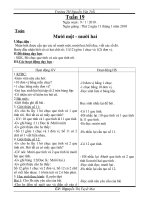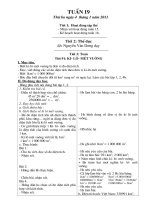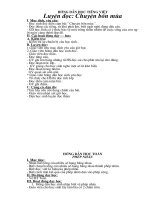Tài liệu Chapter 19 Radioactivity and Nuclear Chemistry
Bạn đang xem bản rút gọn của tài liệu. Xem và tải ngay bản đầy đủ của tài liệu tại đây (4.26 MB, 84 trang )
Chapter 19
Radioactivity
and Nuclear
Chemistry
2011, NKMB Co., Ltd.
Chemistry, Julia Burdge, 2
st
Ed.
McGraw Hill.
Mr. Truong Minh Chien ;
/>
2
The Discovery of Radioactivity
•
Antoine-Henri Becquerel designed an
experiment to determine if phosphorescent
minerals also gave off X-rays
Chemistry, Julia Burdge, 2
nd
e., McGraw Hill.
3
The Curies
•
Marie Curie used electroscope to
detect uranic rays in samples
•
Discovered new elements by
detecting their rays
radium named for its green
phosphorescence
polonium named for her homeland
•
Since these rays were no longer
just a property of uranium, she
renamed it radioactivity
Chemistry, Julia Burdge, 2
nd
e., McGraw Hill.
4
Types of Radioactive Rays
•
Rutherford discovered there were three
types of radioactivity
•
alpha rays (α)
have a charge of +2 c.u. and a mass of 4 amu
what we now know to be helium nucleus
•
beta rays (β)
have a charge of -1 c.u. and negligible mass
electron-like
•
gamma rays (γ)
form of light energy (not particle like α and β)
Chemistry, Julia Burdge, 2
nd
e., McGraw Hill.
5
Rutherford’s Experiment
++++++++++++
--------------
α
γ
β
Chemistry, Julia Burdge, 2
nd
e., McGraw Hill.
6
Penetrating Ability of Radioactive
Rays
α
β
γ
0.01 mm 1 mm 100 mm
Pieces of Lead
Chemistry, Julia Burdge, 2
nd
e., McGraw Hill.
7
Facts About the Nucleus
•
Every atom of an element has the same number of
protons
atomic number (Z)
•
Atoms of the same elements can have different
numbers of neutrons
isotopes
different atomic masses
•
Isotopes are identified by their mass number (A)
mass number = number of protons + neutrons
Chemistry, Julia Burdge, 2
nd
e., McGraw Hill.
8
Facts About the Nucleus
•
The number of neutrons is calculated by
subtracting the atomic number from the mass
number
•
The nucleus of an isotope is called a nuclide
less than 10% of the known nuclides are non-
radioactive, most are radionuclides
•
Each nuclide is identified by a symbol
Element -Mass Number = X-A
X Element
A
Z
number mass
number atomic
=
Chemistry, Julia Burdge, 2
nd
e., McGraw Hill.
9
Radioactivity
•
Radioactive nuclei spontaneously decompose into
smaller nuclei
Radioactive decay
We say that radioactive nuclei are unstable
•
The parent nuclide is the nucleus that is undergoing
radioactive decay, the daughter nuclide is the new
nucleus that is made
•
Decomposing involves the nuclide emitting a particle
and/or energy
•
All nuclides with 84 or more protons are radioactive
Chemistry, Julia Burdge, 2
nd
e., McGraw Hill.
10
Important Atomic Symbols
Particle Symbol Nuclear
Symbol
proton p
+
neutron n
0
electron e
-
alpha
α
beta
β, β
−
positron
β, β
+
p H
1
1
1
1
n
1
0
e
0
1−
He α
4
2
4
2
e β
0
1
0
1 −−
e β
0
1
0
1 ++
Tro, Chemistry: A Molecular Approach 11
Transmutation
•
Rutherford discovered that during the radioactive process,
atoms of one element are changed into atoms of a
different element - transmutation
Dalton’s Atomic Theory statement 3 bites the dust
•
in order for one element to change into another, the
number of protons in the nucleus must change
Tro, Chemistry: A Molecular Approach 12
Nuclear Equations
•
we describe nuclear processes with nuclear equations
•
use the symbol of the nuclide to represent the nucleus
•
atomic numbers and mass numbers are conserved
use this fact to predict the daughter nuclide if you know parent
and emitted particle
Tro, Chemistry: A Molecular Approach 13
Alpha Emission
•
an α particle contains 2 protons
and 2 neutrons
helium nucleus
•
most ionizing, but least penetrating
•
loss of an alpha particle means
atomic number decreases by 2
mass number decreases by 4
Rn He Ra
218
86
4
2
222
88
+→
He α
4
2
4
2
Tro, Chemistry: A Molecular Approach 14
Tro, Chemistry: A Molecular Approach 15
Beta Emission
•
a β particle is like an electron
moving much faster
produced from the nucleus
•
when an atom loses a β particle its
atomic number increases by 1
mass number remains the same
•
in beta decay, a neutron changes into a proton
Pa e Th
234
91
0
1
234
90
+→
−
e β
0
1
0
1 −−
Tro, Chemistry: A Molecular Approach 16
Tro, Chemistry: A Molecular Approach 17
Gamma Emission
•
gamma (γ) rays are high energy photons of light
•
no loss of particles from the nucleus
•
no change in the composition of the nucleus
Same atomic number and mass number
•
least ionizing, but most penetrating
•
generally occurs after the nucleus undergoes some
other type of decay and the remaining particles
rearrange
γ
0
0
Tro, Chemistry: A Molecular Approach 18
Positron Emission
•
positron has a charge of +1 c.u. and
negligible mass
anti-electron
•
when an atom loses a positron from the
nucleus, its
mass number remains the same
atomic number decreases by 1
•
positrons appear to result from a proton
changing into a neutron
Ne e Na
22
10
0
1
22
11
+→
+
e β
0
1
0
1 ++
Tro, Chemistry: A Molecular Approach 19
Tro, Chemistry: A Molecular Approach 20
Electron Capture
•
occurs when an inner orbital electron is pulled
into the nucleus
•
no particle emission, but atom changes
same result as positron emission
•
proton combines with the electron to make a
neutron
mass number stays the same
atomic number decreases by one
Tc Ru
Tc e Ru
92
43
92
44
92
43
0
1
92
44
→
→+
−
e
0
1−
Tro, Chemistry: A Molecular Approach 21
Particle Changes
•
Beta Emission – neutron changing into a proton
β
0
1
1
1
1
0
−
+→ pn
•
Positron Emission – proton changing into a neutron
β
0
1
1
0
1
1
+
+→ np
•
Electron Capture – proton changing into a neutron
1
0
0
1-
1
1
nep →+
22
Tro, Chemistry: A Molecular Approach 23
Nuclear Equations
•
in the nuclear equation, mass numbers and
atomic numbers are conserved
•
we can use this fact to determine the
identity of a daughter nuclide if we know
the parent and mode of decay
Tro, Chemistry: A Molecular Approach 24
Ex 19.2b - Write the Nuclear Equation for
Positron Emission From K-40
1) Write the nuclide symbols for both the starting
radionuclide and the particle
e positron
K 04K
0
1
40
19
+
=
=−
Tro, Chemistry: A Molecular Approach 25
Ex. 19.2b - Write the Nuclear Equation for
Positron Emission From K-40
2) Set up the equation
•
emitted particles are products
•
captured particles are reactants
X e K
A
Z
0
1
40
19
+→
+









